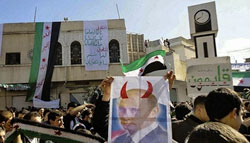
The worsening civil war in Syria is putting undue pressure on its 20 million citizens, and the stakes are growing as the tensions spill over into the region and further draw in allies for both sides.
Below are resources recommended by staff at the International Peace Institute (IPI) on ways to follow the ever-changing conflict, some of which provide comprehensive and unique perspectives on the issues at stake.
Articles
“Give Peace Talks a Chance,” Foreign Affairs
Despite the dark clouds looming over this summer’s proposed Geneva peace talks, J. Michael Quinn and Madhav Joshi lay out a concrete argument for giving the talks a chance. Many of the challenges the talks face—external actors bringing their own agendas, a fragmented opposition, unrealistic preconditions—are common problems, say the professors from the University of Notre Dame’s Kroc Institute for International Peace Studies. Rather than add to the doom and gloom, they draw on lessons from negotiations elsewhere to lay out procedural and substantive steps the conveners could take to overcome some of these difficulties. “Negotiations at the beginning of a peace process are generally less successful than later rounds,” they say, but each round can pave the way for successful talks in the future. Suggested by Marie O’Reilly, Associate Editor at IPI.
“The Thin Red Line: Inside the White House debate over Syria,” New Yorker
Obama may have just appointed two liberal interventionists to his foreign policy team in the form of Samantha Powers and Susan Rice, but that doesn’t mean we should expect the American administration to lead a new humanitarian crusade. Dexter Filkins’ in-depth examination of Obama’s tenuous red line on Syria remains the most thorough explanations of the White House’s reluctance to use military force in Syria, despite mounting pressure. Suggested by Marie O’Reilly, Associate Editor at IPI.
“The Syrian Heartbreak,” Middle East Research and Information Project
In this powerfully written essay, International Crisis Group’s Peter Harling and The Economist’s Sarah Birke offers a sobering look into the dynamic nature of the conflict which has torn apart the urban and social fabric of the once peaceful country. Providing insightful analysis, the essay traces how the conflict has fractured Syrian national identity, making it all the more difficult to pick up the piece once the war is over. Suggested by Nadia Mughal, Research Assistant at IPI.
Online platforms
The site provides a comprehensive look into the on goings of the conflict, featuring daily headlines, audio briefings, social media roundups, interviews and articles from people on the ground. Described by co-founder Lara Setrakian as “a platform that fuses journalism and technology to better cover a complex story,” Syriadeeply represents a new tool in digital journalism that focuses solely on one particular issue. Suggested by Nadia Mughal, Research Assistant at IPI.
Syrian Observatory for Human Rights
The grandly named Syrian Observatory for Human Rights is an anti-Assad group based in Britain with a network of contacts inside Syria which is keeping track of the death toll and aggregates news on the conflict. SOHR’s methodology for counting civilian victims has been questioned, but its numbers have been cited by virtually every Western news outlet since the beginning of the uprising. Its founder, Rami Abdul Rahman, fled Syria 13 years ago. Suggested by Francesco Mancini, Director of Research at IPI.
An excellent source of constant news and images on the conflict, Al Jazeera’s Syria blog includes the award winning interactive feature tracking the Syrian regime’s defections. Suggested by Francesco Mancini, Director of Research at IPI.
Syria Comment is run by Joshua Landis, Associate Professor at the University of Oklahoma. On top of a few knowledgeable permanent contributors, experts on different Syria-related aspects, or just regular people with interesting insights have been posting their analysis there as well, enriching the blog with quite a wide variety of angles and views. Landis is a longtime follower of Syrian affairs with the archives going back to 2004 and nowadays makes frequent appearance in mass circulation media. Suggested by Jose Vericat, IPI Advisor, Middle East.
Humanitarian Developments
To keep a watch of the deteriorating humanitarian situation in Syria, Reliefweb aggregates on a daily basis press articles, analytical reports, humanitarian agencies’ assessments, situation reports, and press releases related to Syria, drawing on a wide array of sources. This is usefully complemented by the UN Office for the Coordination of Humanitarian Affairs’ website and a dedicated webpage that give direct access to key documents related to the coordination of the humanitarian response in the country, including by sector of activity (food, health, livelihood, nutrition, shelter, protection, etc.). To track the impact of the crisis in the broader region, UNHCR’s “Syria Regional Refugee Response” web portal gives an up-to-date overview of Syrian refugee flows and numbers in the Middle East, as well as country-by-country figures. Finally, the Syria Needs Analysis Project provides independent analysis and monthly comprehensive reports on the humanitarian situation, including detailed maps of Syria and affected districts. Suggested by Jeremie Labbé, IPI Senior Policy Analyst, Humanitarian Affairs.
Multimedia
Watching Syria’s War, The New York Times
This extensive compilation of primary source videos—including graphic images of violent incidents and civilian deaths—may not help bring peace to Syria any sooner. But the project, which has been adding video clips since June 25, 2012, may have major implications for human rights investigation and documentation. Perhaps by bringing evidence of human rights violations to a mass audience throughout a conflict, the push for accountability and transitional justice mechanisms in a future postconflict Syria will be stronger and achieved more swiftly than in other cases. For now, this is a useful site to “track the human toll of the conflict” in places like Damascus, Aleppo, Qusayr and elsewhere. Suggested by Andrea Ó Súilleabháin, Visiting Fellow at IPI.




